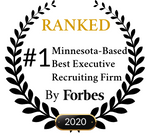3 ways to protect your unfilled roles
In spite of national and state-wide continued strong job reports, worries about a potential slowdown are starting to show in some employers’ budgeting decisions. If you have been struggling to fill empty but critical roles within your organization, you may have heard rumblings about potential hiring freezes or worse, open positions being eliminated altogether.
In reality, we’re not seeing a lot of that here in the Twin Cities. Most employers recognize the urgent need to fill key jobs and continue to engage us at a near-record pace to recruit the talent they need to remain competitive. According to Conference Board’s Midyear 2022 C-suite Outlook, the majority of CEO’s believe that we are either already in a recession or facing one within the coming year.
Yet critically, these same respondents continue to see their investments in people as “key to long-term growth” are actively working to do whatever it takes to attract talent. Hybrid work models, improving technology, and strengthening workplace culture are among their highest priorities.
But all economies run in cycles. If your organization decides to take a closer look at the human resources budget, are you prepared to answer this one question:
“Do you really need this position?”
It’s time to get prepared. To get there, here are the 3 steps you can take right now.
1.) Shift your framework from expense to ROI.
Stop perceiving your open position as an expense. It’s not. It’s an investment. A well-designed job is built for one purpose only: to strengthen your organization, not deplete it. The hiring managers who successfully protect and fill their open positions are those who can answer successfully these questions:
- What will your organization lose if you lose that position?
- How can you quantify the value of that job?
If your new hire won’t directly contribute to revenue or cost savings, it’s on you to connect the dots between the value they’ll add and your company’s bottom line, using the metrics of the position’s key accountabilities.
2.) Revisit your own process, priorities, and team needs.
If you’re repeatedly failing to sign the right candidate, ask what’s getting in the way. Then fix what needs fixing. Are all of your must-haves still deal-breakers? Are you following up with the candidates you’ve lost to ask them why those a different employers – and to truly listen to and learn from what they tell you?
Top candidates frequently tell me that their reasons for passing on an employer include an unwillingness to provide hybrid or at-home work schedules, negative perceptions of team culture, and poor candidate experience often marked by inexplicably slow interview scheduling and slow communication. In other words, it’s not always about the compensation. It’s about things you can directly control or influence.
3.) Bring in an executive recruiter.
As the urgency to fill key positions increases, the benefits of enlisting a recruiter to grow exponentially. Go back to your business case for the job itself. When you’re clear on the role’s value to the company, the argument for improving your chances of landing the best candidate, quickly, also becomes very clear. Reach out. Talk to proven executive recruiting professionals who specialize in your industry. Ask them about their process, their track record, their confidence level in meeting your needs, and yes, their fees.
At SkyWater Search Partners, we specialize in helping companies achieve their business goals by bringing them the talent they need to stay competitive and build their bench strength. If you would like to know more about how we can help you, please reach out. We would love to talk!









